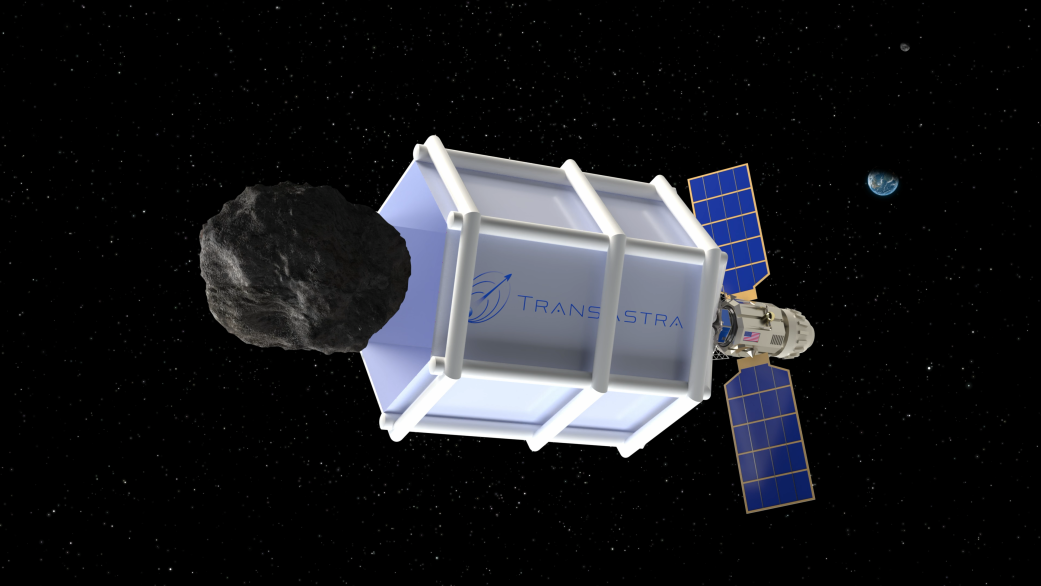Science
Startups Race to Capture Asteroids with Innovative Technology

Asteroids, rich in both precious and common metals, are becoming the focus of several startups aiming to revolutionize mineral extraction. These celestial bodies present a potential alternative to Earth-based mining, which faces challenges such as diminishing resources and environmental concerns. Among the frontrunners in this field is California-based TransAstra, which has developed a device called the Capture Bag. This inflatable bag, available in various sizes, is designed to capture everything from small rocks to large boulders. Additionally, TransAstra’s technology aims to address the growing problem of space debris, which poses risks to satellites and other space operations.
Joel Sercel, an aerospace engineer and founder of TransAstra, emphasized the complexity of asteroid mining: “To solve the asteroid mining problem, you actually have to solve four other problems that we call detect, capture, move and process.” This means that a mining system must be capable of detecting asteroids, capturing them, transporting them safely in space, and processing them for their valuable minerals. Sercel stated, “We have tech in all those areas,” highlighting the company’s impressive portfolio of approximately 21 patents, with one issued nearly every month.
In early October 2023, TransAstra completed a preliminary test of the Capture Bag aboard the International Space Station. This test, while not involving an actual capture, marks a significant step forward. With funding from private investors and contracts with NASA and the US Space Force, the company is now preparing to develop a larger, more functional version of the device.
Asteroid Mining’s Potential
Sercel has identified specific asteroids worth mining, focusing on a group of bodies with orbits similar to Earth’s. “They drift very slowly by the Earth, at a distance of just a few billion kilometers,” he noted. The goal is to conduct a mining operation as early as 2028, a venture he believes could ignite an industrial revolution in space.
To date, TransAstra has raised about $12 million from venture capital and around $15 million from various contracts and grants. The challenge of collecting samples from asteroids remains significant, as evidenced by the failure of other companies, such as Planetary Resources and Deep Space Industries, which ceased operations without achieving notable results. Only three missions have successfully returned asteroid samples, all conducted by government agencies at a cost of hundreds of millions of dollars.
TransAstra has deployed approximately a dozen telescopes across Arizona, California, and Australia as part of a network to identify asteroids suitable for mining. A fourth telescope is planned to be established in Spain. Naming these telescopes Sutter, after the site of California’s gold discovery, Sercel believes that this prospecting will lead to a space “gold rush.”
Once a target asteroid is identified, TransAstra’s Capture Bag will be employed to secure it. Made from aerospace-grade materials like kevlar and aluminum, the bag is leak-proof and can be mounted on a carrier vehicle. Upon release, it inflates to accommodate its target. The bags come in six sizes, from micro to super jumbo, capable of capturing objects ranging from small debris to a 10,000-ton asteroid, comparable to a small building.
TransAstra is currently working on a 10-meter version of the Capture Bag, with funding of $5 million, half of which comes from NASA. Sercel anticipates completing the engineering phase in just over a year, after which the bag will be ready for a space flight. Before targeting asteroids, the bag will undergo testing with space debris, which Sercel regards as essential to mitigate risks associated with asteroid mining.
“This 10-meter capture bag will be big enough to find satellites in graveyard orbits that may cause navigational issues,” Sercel explained. “It will capture them and move them to a safer location, which is an important mission.” He remains confident that asteroid mining will facilitate the production of necessary materials for space hardware, allowing for in-space processing and manufacturing.
Growing Interest in Space Solutions
The convergence of interests in space junk removal and asteroid mining has attracted substantial investment and attention. Earlier this year, US-based startup Astroforge launched Odin, a probe intended to assess an asteroid for mining purposes. Although it became the first privately funded mission to an asteroid, communication with the probe was lost shortly after launch.
While various technological solutions have been proposed for capturing space debris, such as robotic arms and harpoons, Sercel argues that the Capture Bag’s simplicity and robustness give it a competitive edge. “The same capture bag can be used to capture objects of different shapes, as long as the bag is big enough,” he stated. Initially, each bag may cost millions of dollars, but as production scales, costs are expected to decrease, making it more economically viable than robotic alternatives.
According to Eleonora Botta, an associate professor at the University at Buffalo, the versatility of the Capture Bag is a significant advantage for both asteroid capture and space debris management. “One of the major engineering challenges lies in deploying large, highly flexible structures in the vacuum and microgravity conditions of space,” she noted. This aspect will be vital as the system evolves from its experimental version tested on the ISS.
John Crassidis, also a professor at the University at Buffalo, highlighted the innovative approach TransAstra is taking in asteroid mining. “If it works, then it’ll really open the doors for asteroid mining, because there are many small ones out there that we can’t see right now,” he remarked. Although he considers the 2028 timeline ambitious, he hopes that TransAstra will achieve its goals.
As the race to mine asteroids intensifies, the successful development of the Capture Bag could pave the way for a new era of resource extraction in space, with implications for both the economy and the environment on Earth.
-

 Technology5 months ago
Technology5 months agoDiscover the Top 10 Calorie Counting Apps of 2025
-

 Health3 months ago
Health3 months agoBella Hadid Shares Health Update After Treatment for Lyme Disease
-

 Health3 months ago
Health3 months agoErin Bates Shares Recovery Update Following Sepsis Complications
-

 Technology4 months ago
Technology4 months agoDiscover How to Reverse Image Search Using ChatGPT Effortlessly
-

 Technology1 month ago
Technology1 month agoDiscover 2025’s Top GPUs for Exceptional 4K Gaming Performance
-

 Technology3 months ago
Technology3 months agoElectric Moto Influencer Surronster Arrested in Tijuana
-

 Technology5 months ago
Technology5 months agoMeta Initiates $60B AI Data Center Expansion, Starting in Ohio
-

 Technology5 months ago
Technology5 months agoRecovering a Suspended TikTok Account: A Step-by-Step Guide
-

 Health4 months ago
Health4 months agoTested: Rab Firewall Mountain Jacket Survives Harsh Conditions
-

 Lifestyle5 months ago
Lifestyle5 months agoBelton Family Reunites After Daughter Survives Hill Country Floods
-

 Health3 months ago
Health3 months agoAnalysts Project Stronger Growth for Apple’s iPhone 17 Lineup
-

 Technology4 months ago
Technology4 months agoHarmonic Launches AI Chatbot App to Transform Mathematical Reasoning





















